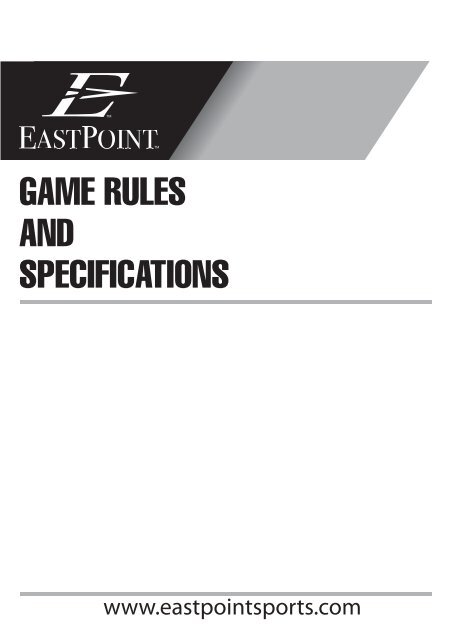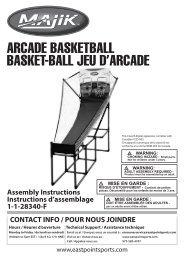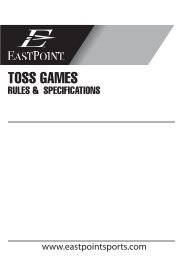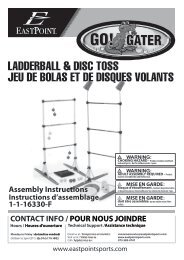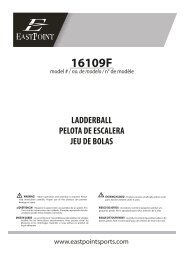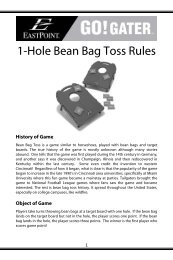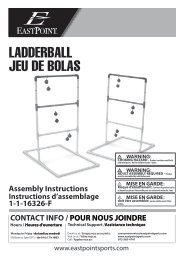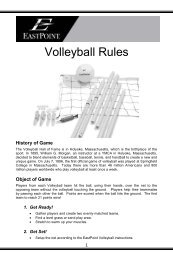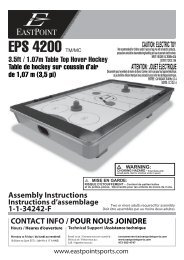GAME RULES AND SPECIFICATIONS - EastPoint Sports
GAME RULES AND SPECIFICATIONS - EastPoint Sports
GAME RULES AND SPECIFICATIONS - EastPoint Sports
- No tags were found...
You also want an ePaper? Increase the reach of your titles
YUMPU automatically turns print PDFs into web optimized ePapers that Google loves.
Make each side of the court equal in size. See Figure A below. Werecommend measuring 22-feet deep per side. If you do not havemeasuring tape or enough space for 22-feet deep on each side, useyour stride to step out the same number of steps per side.Mark the back four corners of the court for out-of-bounds. We like touse extra T-shirts as markers.Practice your serve as shown in Figure B below. The Badmintonracket must make contact with the shuttlecock below the waist on aserve. Rally for serve. The player or team who wins the rally decideswhether to serve first or choose their end of the court.Figure A:Badminton CourtFigure B:Badminton Serve4
3. Go Play! Doubles and SinglesKeep score with the rubber rings on the net poles. As each player orteam gains a point, they move their ring up a number on the pole.The first player or team to reach 21 wins the game!To begin the game, the server uses their <strong>EastPoint</strong> Badminton racketto hit the shuttlecock over the net. The serve must travel diagonally(i.e., cross court) to be good. The server has two tries to make agood serve. If the serve is successful, the server and opponent, orthe serving team and the opposing team for doubles, volley theshuttlecock until it hits the ground. Now play for that point is over. Remember, only the serving side can score a point! The servingside scores a point when:1. The opponent hits the shuttlecock and it lands out ofbounds;2. The opponent fails to hit it over the net; or3. The shuttlecock lands within bounds in the opponent’scourt.The opponent wins the serve when the server, or serving team fordoubles:1. Fails to make a good serve in two tries;2. Fails to return the shuttlecock; or3. Hits it out of bounds.A shuttlecock can be played off the net during a volley.A shuttlecock hitting a boundary line is "in."Faults in the game of Badminton result in the loss of a point or theloss of a serve. They are often called “outs.” They include thefollowing:1. One player hitting the shuttlecock twice in succession;2. A shuttlecock hitting the ground completely outside theboundary line;3. A shuttlecock that passes through the net is “out.” Yes, itis possible.4. A shuttlecock that is caught in the net is “out.” When thishappens just release the shuttlecock from the net;5. A shuttlecock that is caught in the player's racquet. This,this too is possible. When this happens just release theshuttlecock from the racket;6. A shuttlecock that touches the ceiling or walls; and7. A shuttlecock that touches the player or the clothes of theplayer.4. Singles RulesWhen the server's score is an even number, the serve is taken fromthe right side.When the server's score is an odd number, the serve is taken fromthe left side.5
5. Doubles RulesThe server serves the shuttlecock from the right service court acrossthe court to the opponent that is diagonally across from the server.The server has two serves to make this happen or else loses theserve.Only the opponent who is diagonally across from the server is allowedto hit the shuttlecock on that play. If the opponent’s partner touchesor hits the shuttlecock, this is a fault and the serving team scores apoint.When serving at the start of a Badminton game, the serve andreceive is from the right service court.When the serving side has scored an even number of points, serveand receive from the right service court.When the serving side has scored an odd number of points, serveand receive from the left service court.Game VariationsA Shorter GameReduce the amount of points needed to win the game to 15 or 11 points forquicker game play.Majik Smash TMMajik Smash can be played according to the badminton rules listed above orplay without the net and count how many times players can hit the Majik Shuttleback and forth without it hitting the ground.Game TriviaSixteen feathers from the left wing of a goose are used to make professionalshuttlecocks. This gives the professional shuttlecocks a precise and standardspin. By the way, no geese were harmed to produce the <strong>EastPoint</strong> Badmintonshuttlecocks!6
VolleyballHistory of GameThe Volleyball Hall of Fame is in Holyoke, Massachusetts, which is the birthplaceof the sport. In 1895, William G. Morgan, an instructor at a YMCA in Holyoke,Massachusetts, decided to blend elements of basketball, baseball, tennis, andhandball to create a new and unique game. On July 7, 1896, the first officialgame of volleyball was played at Springfield College in Massachusetts. Todaythere are more than 46 million Americans and 800 million players worldwide whoplay volleyball at least once a week.Object of GamePlayers from each Volleyball team hit the ball, using their hands, over the net tothe opposing team without the volleyball touching the ground. Players help theirteammates by passing each other the ball. Points are scored when the ball hitsthe ground. The first team to reach 21 points wins!1. Get Ready!Gather players and create two evenly-matched teams.Find a level grass or sand play area.Stretch to warm up your muscles.2. Get Set!Setup the net according to the <strong>EastPoint</strong> Volleyball instructions.Make each side of the court equal in size. See Figure C below. We7
ecommend measuring 30-feet deep per side. If you do not havemeasuring tape or enough space for 30-feet deep on each side, useyour stride to step out the same number of steps per side.Mark the back four corners of the court for out-of-bounds. We like touse extra T-shirts as markers.Practice your serve. See Figures D and E for an underhand andoverhand serve, respectively.Volley for serve. The team who wins the volley serves first.Figure C:Volleyball CourtFigure D:Volleyball Underhand Serve3. Go Play! The first team scoring 21 points wins the Volleyball game. Only the serving team can score a point. For example, when the8
opposing team hits the Volleyball out of bounds, or fails to get it overthe net without it hitting the ground first, the serving team gets a point.If the serving team hits the ball and it lands within bounds in theopponent’s court, the serving team gets the point.When the serving team hits the ball out of bounds or fails to get it overthe net without it hitting the ground first, the serving team loses theirserve. Now the opposing team has the serve.One player may not hit the ball twice in succession. It is considered afoul and results in losing the point.If your team has the ball, your team has only three passes to make itover the net.The ball can be played off the net during a volley, but not by the sameplayer who hit it into the net. This is considered a double hit.A ball hitting a boundary line is "in."A ball is "out" if it hits the ground completely outside the boundarylines.Players may not lift, carry, or throw the ball.When a team gains the serve, the team rotates positions moving in aclockwise direction. This ensures that each player has a chance toserve.Game VariationsBeach VolleyballPlay your <strong>EastPoint</strong> Volleyball game on the sand at the beach!Game Trivia The longest recorded volleyball marathon by two teams of six is 75hours 30 minutes at Kingston, North Carolina in 1980. Volleyball terms:o An “ace” is when the ball is served to the other team, and no onetouches it.o A “sideout” is when the team that served the ball makes amistake, causing the ball to go to the other team.o A “roof” is when a player jumps above the height of the net, andblocks the ball.o A “stuff” is when a player jumps about the height of the net,blocks the ball, and the ball goes back at the opposing personwho spiked the ball.o A “dig” is when a player makes a save from a very difficult spike.o A “kill” is when a team spikes the ball and it either ends in a pointor a sideout.9
CroquetHistory of GameThe exact origins of Croquet are unknown to historians. What we do know is thatEuropeans played similar games with wooden hoops, balls, and mallets since the13 th century. The Irish game called Crookey, which resembled Croquet, was firstplayed around 1830 and was brought to England twenty years later. OlympicCroquet was played at the 1900 and 1904 summer games and today the sport iscompetitive in over twenty countries, the major ones being Australia, NewZealand, the United Kingdom, and the USA. <strong>EastPoint</strong> Croquet has beendesigned for the whole family to enjoy.Object of GameCroquet is played by two opposing teams. Players drive their ball with a malletthrough wickets along a Croquet course. When a player hits their Croquet ball tothe final stake after making it through the Croquet course, they have completedthe course. The first team to complete the course wins. When all the players on ateam have completed the course, the game is over.1. Get Ready!Gather 2 to 6 players (depending on your set).Divide players into two teams.Find a level playing area. A standard Croquet course is 50 feet wideby 100 feet long, but may be adapted to fit any back yard by reducingthe size or changing the shape of the course.Stretch to warm up your muscles.10
2. Get Set! Setup the mallets according to the <strong>EastPoint</strong> Croquet instructions. Layout the <strong>EastPoint</strong> Croquet course similar to Figure F. Practice swinging the <strong>EastPoint</strong> Croquet mallet and hitting the<strong>EastPoint</strong> Croquet balls through the wickets. One team will be “hot,” and the other will be “cool.” Red, orange, andyellow Croquet balls are for the “hot” team, and green, black, and blueCroquet balls are for the “cool” team. Assign a Croquet ball color to each player. Look for the order of play on the end stakes showing colors from topto bottom. Realize that going first may not give a team or player anyadvantage.Figure F:<strong>EastPoint</strong> Croquet Layout11
Figure G:Hitting the Croquet Ball3. Go Play!Play through the Croquet course follows the arrows shown in FigureF.Start the game by placing the first ball mid-way between the firststake and the first wicket. The first player hits the ball with the malletthrough both wickets into the Croquet course. If the Croquet ballpasses through both wickets, the player receives two extra strokes,one for each wicket.When the first player is done, the next player hits their Croquet ball.Alternate between each team in order by Croquet ball color until allplayers have completed the course and hit the “home” stake.Place out-of-bound Croquet balls back in the Croquet court atapproximately the place where the Croquet ball went out of bounds,one mallet length inward from the court boundary.Get an extra stroke on a turn for (1) going through a wicket, (2) hittinga stake, or (3) hitting another ball. When a player hits another player'sball, it is called a roquet.12
After roqueting an opponent’s ball, a player may select one of fouroptions:1. Play two extra strokes from where their own Croquet ball lands.2. Place their own Croquet ball a single mallet head of length awayfrom the roqueted ball, in any direction the player chooses. Taketwo bonus strokes from the new position.3. Place their own Croquet ball next to the roqueted ball. Then hittheir own Croquet ball with their mallet so that it moves both ballsin a desired direction. The player now has one extra stroke.4. Place their own Croquet ball next to the roqueted ball. Then,placing his or her foot on their own Croquet ball, use the mallet tostrike their own Croquet ball so as to move the other Croquet ballwithout moving their own. The player now has one extra stroke.Discuss these additional rules with the players:o Extra strokes are not accumulated. They must be usedimmediately. Every stroke counts, even if the ball barely moves!o Play extra strokes from where the Croquet ball is located aftergoing through a wicket or hitting a stake.ooooooooPlaying out of turn results in a player losing their next turn.A player who strikes another player’s Croquet ball instead of theirown must replace the other player’s Croquet ball and loose aturn.A player may try again if he or she missed their Croquet ball on amallet swing.Always strike the Croquet ball with a mallet. Pushing the ball withthe mallet is not allowed. Using a foot or hand to stop the ball isalso not allowed.A ball has not completely passed through the wicket if the handleof the mallet can touch the ball when laid across the wicket fromthe side that the Croquet ball exited the wicket.Do not roquet an opponent’s Croquet ball a second time beforeyour own Croquet ball hits another ball, passes through a wicket,or hits a stake.No ball can roquet or be roqueted until it passes through the firstwicket.It is sometimes a team's advantage for a player to pass throughall the wickets, but not hit the final stake. This allows the playerto return to the field to help other team members. This player,however, must eventually go back and hit the final stake in orderto complete the Croquet course. An opponent may roquet such aplayer’s Croquet ball into the final stake just to get him or her outof the game.13
Game VariationsSnow CroquetPlay your <strong>EastPoint</strong> Croquet game in the snow! Pack loose snow down in aplaying area. Use packed snow to hold down wickets. Bundle up, use yourgloves and mittens, and have fun!Beach CroquetPlay your <strong>EastPoint</strong> Croquet game on the sand at the beach! Select an openbeach area for the Croquet court that is away from people, their pets, and water.Consider a smaller Croquet court if the sand terrain is rough and rocky. Considera larger Croquet court if the sand terrain is level and smooth. Have fun!Game Trivia Russian cosmonauts were reported playing Croquet to relax andrehabilitate upon their return from space missions. Croquet has been played at both the North and South Poles.14
HorseshoesHistory of GameThe game of horseshoes, as we know it today, began with American soldiers ofthe Revolutionary War and the Civil War passing time with iron tent stakes andused mule shoes. The first World Horseshoe Tournament was held in thesummer of 1910 in Bronson, Kansas. Today the sport is played in backyardsand professional courts throughout the United States and Canada.Object of GameThe main object of horseshoes is to ring a stake with the horseshoe or throw it asclose to the stake as possible, gaining points or canceling out the opponent’spoints on an inning. The game is broken into innings. Each inning consists offour pitched horseshoes, two by each opponent. Play continues until one playeror team reaches a predetermined score of 15, 21 or 40 points.1. Get Ready!Gather two or four players. If four people are playing, make two teamsof two players.Find a flat, level playing area at least 6 feet wide and 50 feet long.Stretch to warm up your muscles.2. Get Set!Mark off two spots for the stakes 40 feet apart. Drive the stakes intothe ground with a hammer until they extend 14 to 15 inches above thesurface. Lean the stakes slightly toward each other no more thanthree inches. See Figure H.Anyone not actively throwing horseshoes remains on the opposite15
side of the stake at least 3 feet away.Do not walk to the opposite stake prior to the completion of thethrows. Keep children and pets away from the playing area at alltimes!Practice throwing the horseshoe. Guidance on throwing is providedbelow:o Turns are the number of flips the shoe makes in flight. To get ahorseshoe to turn, hold it by one of the shanks. See Figure I.o Hold the horseshoe as you would hold a dish or letter betweenyour fingers and your thumb. The index finger and middle fingersare under the bottom of the horseshoe and curl over the inneredge of the horseshoe. Use your little and ring fingers to balancethe horseshoe.o To get a 1 1/4 turn, hold the horseshoe near the middle of eithershank. To get a 1 ¾ turn, hold the horseshoe on the shank closeto the caulk on the bottom. Try both ways to see which worksbest for you.Decide on game points before starting the game. Possible gamepoints include 15, 21, or 40 points.Flip a coin to determine the player or team who throws first to beginthe game.Figure H:Horseshoe Playing AreaFigure I:Holding the Horseshoe16
3. Go Play!The winner of the coin toss pitches both horseshoes to the opposingstake. Then, the opponent pitches from the same side. Whenpitching a horseshoe, players must not cross the foul line, which isthree feet in front of the stake.With just two players, opponents play from the same stake. In teamplay, players on the same team split up, one at each stake, so thatthe team faces one another 40 feet apart.Before throwing a horseshoe, announce the inning and game score.Score points as described in the following list and as shown in FigureJ:o Move to the target stake to score points. With four players, thetwo players standing near the target stake score the points.o Do not move horseshoes until the points have been scored.o A horseshoe encircling the stake is called a ringer and counts forthree points.o A horseshoe leaning on the stake counts two points.o The closest horseshoe to the stake is worth one point, but it hasto be closer to the stake than the width of a horseshoe.o The total score for that inning is the remaining score after allcanceling throws, if any, are deducted.o In the case of a tie, play a two-inning tie breaker.Play the next inning in the reverse direction. In team play, the twoopponents who have not yet pitched now pitch in the reversedirection.Continue playing innings until one player, or team, scores the gamepoint.Figure J:Scoring in HorseshoesRinger - 3Points1 Point Leaner – 2Points17
Game VariationsFor An Easier GameShorten the distance between the two stakes.Game TriviaFollowing the American Revolutionary War, it was said by England'sDuke of Wellington that "the War was won by pitchers of horsehardware."18
BocceHistory of GameThrowing balls toward a fixed target is the oldest game known to humankind. Asearly as 5200 B.C., Egyptian historical images of figures tossing a ball orpolished stone have been recorded. The game made its way to Greece around800 B.C. The Romans then learned the game and introduced it to what is nowmodern Italy. The Roman influence in bocce is preserved in the game’s name.Bocce is derived from the Latin word bottia. Today, Bocce is a game of thoughtand strategy that brings families and friends together.Object of GameThe object of the game is to score the most points by ending each round withyour team’s Bocce balls closest to the point ball. The point ball is small and iscalled the “pallino.” There are two to four players on a team. Each player is givenone or two Bocce balls. Each player then takes turns rolling or throwing theBocce ball toward the pallino, which has already been thrown onto the field. Theteam with the most Bocce balls closest to the pallino wins the frame. To increasetheir chances of winning a frame, players may throw their Bocce balls, strikingthe pallino or other Bocce balls in the field to separate opponent’s balls from thepallino. A Bocce match consists of an odd number of frames (e.g., 1, 3, 5, 7, 9,or 11) agreed on by the players before the game. The team who wins the mostframes wins the Bocce match!1. Get Ready!<strong>EastPoint</strong> Bocce can be played upon any level surface by anyonewho is willing to play.Gather two to eight players.19
You may modify the game to accommodate two to eight players. Forexample, if there are two players, each player has four balls to roll orthrow. For eight players, each player has one ball to roll or throw. Inboth cases, however, there are only two teams: a red team and agreen team.2. Get Set!You may play <strong>EastPoint</strong> Bocce on any flat surface. Serious playersmay decide to play on a Bocce court, which is called a “pit.” To set upa pit, see Figure K.If you are not playing in a Bocce pit but want strict rules, make surethat the pallina is thrown at least 30 feet from the throwing area. SeeFigure L. You may use an extra T-shirt to mark off 30 feet or use alandmark such as a tree or rock.Toss a coin to determine which team goes first. The winner of thecoin toss will also choose the color of their team’s Bocce balls, greenor red, and will throw the pallino to begin the frame.Figure K: Bocce Pit Figure L: Backyard Bocce20
3. Go Play!Players stay within the foul line. The player may step on, but shouldnot step over the foul line before releasing the pallino or bocce ball.The team who won the coin toss, goes first. The starting team tossesthe pallino to a valid position. If using a Bocce pit, the pallino mustsettle at least 12 inches from the sideboard and must not hit thebackboard. If, after three attempts, this is not accomplished, theopposing team throws the pallino. Once the pallino is in a validposition, play can move on.Each team decides their own throwing order of each team player.The first player throws the Bocce ball trying to have it land as close tothe pallino as possible. If using a Bocce pit and the Bocce ball hitsthe backboard, that team must throw again. Once the first teamthrows a Bocce ball in bounds, the first team steps aside.The opposing team goes next. The opposing team throws theirBocce balls until all have been thrown or one of their Bocce ballsends up closer to the pallino than the first team’s.The team whose Bocce balls are closest to the pallino is called"inside" and the opposing team "outside."Whenever a team gets inside, it steps aside and lets the outside teamroll.The team outside throws until it beats, not ties, the opposing ball.This continues until both teams have thrown all their bocce balls.If a player rolls the wrong colored ball, simply replace it with thecorrect color when the ball comes to rest.If a player rolls out of turn, the opposing team may leave everything,including the thrown ball, exactly where it is or may return any movedballs to their approximate original positions and remove the thrownball from play.If a Bocce ball is moved before all Bocce balls are played, theopposing team replaces the ball to the approximate original position.This is to be done in the spirit of good sportsmanship.If at the end of any frame the closest ball of each team is equidistantfrom the pallino, the frame ends in a tie.The team with the most Bocce balls closest to the pallino wins theframe.When a team wins a frame, players exchange ends of the Bocce pitand substitutions may be made. The team winning the previous framewill toss the pallino to start the next frame. If playing Bocce in theback yard, players may decide whether to stay in the same playingarea and play in the opposite direction, or move to another part of theback yard.4. Additional Rules When Using a Bocce PitOnce the pallino has been put into play, it remains in play even if ithits the backboard. However, if the pallino is knocked out of the pit orit is knocked in the front of the center line, the frame will end, no21
points are awarded, and the frame will resume from the opposite endof the court with the same team tossing the pallino.If a player's Bocce ball makes contact with the backboard, the Bocceball is considered a dead ball on impact and is removed from playuntil the end of the frame.If a thrown Bocce ball comes to rest on the pallino or another ball thatis touching the back wall, this thrown ball remains in play. The Bocceball touching the back wall is removed from play. If the pallino istouching the back wall it remains in play.If, after hitting the backboard, a Bocce ball strikes a stationary Bocceball, that stationary ball shall be replaced in its original position. Thethrown ball is removed from play.If, after hitting the backboard, a Bocce ball is not removed quicklyenough and strikes a moving ball that likely would have hit thebackboard, allowing the moving ball to remain in play, that movingball remains in play where it comes to rest.5. Rules on ShootingShooting is lofting the ball in the air beyond the center line. Shootingis allowed if the thrown ball hits the ground before hitting the pallino. Ifthe thrown ball does not hit the ground first, everything goes back toits approximate original position. The thrown ball is out of play.Game VariationsPlay Two Matches SimultaneouslyTo speed up play, two matches can be played simultaneously in a single Boccepit by assigning a match to each end of the court. This also provides players atthe opposite end to determine which Bocce balls are “inside” and declare theframe winner.Play Bocce With More Than Eight PlayersWith extra sets of <strong>EastPoint</strong> Bocce, you can play with more than eight players ata time. This will provide you with additional Bocce balls for players to roll andthrow. No matter how many players and Bocce balls there are, only one pallinois needed per frame.Make Your Own RulesBocce for the average players is very simple. Bocce is a versatile game in whichthe rules may be changed according to the players. Play may range from anearly nonexistent set of rules to the strictest of tournament rules. The rulesprovided in this rule book are for recreational players who play in either a Boccepit or a backyard. Feel free to create your own rules for Bocce.22
Game TriviaIn 1896, during a resurgence of popularity, the first Bocce Olympiadwas held in Athens, Greece. Bocce has been a part of internationalsports ever since.23
TetherballHistory of GameThe origins and inventor of Tetherball remain a mystery. Some say thatTetherball originated in Canada, but facts to back up this claim are sparse.Historians have speculated on the origins of Tetherball. One theory traces theorigins of Tetherball to the Maypole rituals of Medieval Europe. In these rituals,villagers put tethers on a pole and hold them in their hands as they dance aroundthe pole. What we do know is this: because a Tetherball is so similar to avolleyball, Tetherball was probably developed after 1895, the year volleyball wasinvented. Actual volleyballs were used in early Tetherball courts, but modernTetherballs are made specifically to be tethered.Object of GameIn Tetherball, possession is everything! Once a player is in control of theTetherball, the opponent’s only chance of winning is to regain control of the ball.Tetherball is a game for two players, one who hits the ball clockwise and theother who hits the ball counterclockwise. The game ends when one playermanages to wind the ball all of the way around the pole in his or her direction sothat it is stopped by the rope. Then that player wins!1. Get Ready!Recruit one other player.Stretch to warm up your muscles.24
2. Get Set!Set up the game according to the <strong>EastPoint</strong> Tetherball instructions.Set up the game on a level playing area outdoors that has a 16-footdiameter circle of space. See Figure M below.Choose sides of the Tetherball court. Each player must stay in his orher half of the Tetherball court.Practice hitting the ball with your open hand or closed fist.Flip a coin to determine who serves. The server decides whichdirection each player will hit the Tetherball. One player hits the ball inthe clockwise direction and the other player hits the ball in the counterclockwise direction.Figure M:Tetherball Playing Area3. Go Play!Once the server serves to start the game, either player can hit the ballfrom that point on.Serves must be hit, not thrown.Penalties in Tetherball are either intentional or unintentional and theyare listed below.25
Unintentional penalties include the following:o Stepping on or crossing the center line;o Touching the rope;o Carrying or throwing the Tetherball (e.g., when hitting the ballback against the direction which it comes, the ball should bounceoff of the hands immediately with no lingering contact); ando Double hitting (e.g., a player can hit the ball only once per wraparound the pole except if the Tetherball hits the pole betweenhits).When an unintentional penalty occurs, the ball is stopped andreturned to the place it was wrapped before the penalty occurred.Both the number of wraps and the height should be recreated. Theplayer, who did not make the penalty, gets to serve. Then eitherplayer can hit the Tetherball from that point on. If the player commitsany three violations, in any combination, the opponent wins the game.The only intentional penalty is grabbing the pole, which immediateresults in the loss of the game.If both players commit a penalty at the same time, then they performa “pole drop.” Both players place one hand on the Tetherball,holding it three feet out from the pole, directly above the center line.They release the Tetherball at the same time. Once the Tetherballhits the pole, either player can hit it and the play continues normally.Game VariationsRemoving Advantage From ServerIn basic Tetherball, the server usually has an advantage because they start withcontrol over the Tetherball. To remove this advantage, require the server to waituntil either the opponent strikes the Tetherball or the Tetherball has wrapped fourtimes around the pole before the server can strike the Tetherball again.Game TriviaIn the 2004 film Napoleon Dynamite, Jon Heder stars as an awkwardteenager who enjoys diversions such as drawing, hip-hop dancing,and playing Tetherball.26
Lawn DartsHistory of GameLike many other games including Horseshoes, Bocce, and Darts, Lawn Darts is atarget game. Throwing an object at a target may be the oldest game on theplanet. While Lawn Darts, as we know it today, originated in the 1950s, it issimilar to the ancient Roman plumbata, lead-weighted darts carried byinfantrymen in the Middle Ages. In 1988, Lawn Darts with sharp points werebanned for sale by the Consumer Product Safety Commission in the UnitedStates. Today, Lawn Darts are made with a blunt weighted tip resulting in a safeversion of the game.Object of Game<strong>EastPoint</strong> Lawn Darts is a target game where the object is to throw the darts sothat the weighted tip lands inside a plastic ring. The first player or team to reach apre-agreed score wins the game. Players score one point for every dart whichlands within the ring. Lawn darts from opposing players within the ring canceleach other out. Two opposing players, or two teams of two players may play<strong>EastPoint</strong> Lawn Darts. This game is easy to learn, simple to play, but difficult tomaster.1. Get Ready!Gather one other player or three other players and create two teams.Select an open area without overhead objects, such as clotheslines ortrees, and about 10 feet wide and 50 feet long.Stretch to warm up your muscles.27
2. Get Set!Place the two target rings about 35 feet apart. The distance betweentarget rings may be decreased for younger players, or increased toabout 60 feet for a more challenging game, if space permits.Watch out for people and pets in the playing area. The players andspectators not currently throwing a Lawn Dart are responsible forwatching to make sure that the game area is safe. They areresponsible for alerting both the throwing player of unsafe conditions,and any nearby people or pets to stop and stay away from the path ofthe Lawn Dart. It is the thrower’s responsibility to be watchful beforeswinging and releasing the Lawn Dart.Practice throwing the Lawn Darts. To throw one, hold it from the top,not the blunt tip, and toss underhand. See Figure N.<strong>EastPoint</strong> Lawn Darts must land with the weighted tip inside the targetring to count for a point. If the tip rests on top of the target ring for anyreason, more than half the tip must be inside the ring to count as apoint. See Figure O.Decide on game points before starting the game. Possible gamepoints include 3, 15, or 21 points.Flip a coin to determine the player or team who throws first to beginthe game.Figure N:Throwing the <strong>EastPoint</strong> Lawn Dart28
Figure O:Scoring for Lawn DartsININOUT3. Go Play!Keep score verbally.A point is scored when a Lawn Dart lands in the target ring. However,if a player lands a Lawn Dart in the target ring, and then an opposingplayer also lands a dart in the target ring, the scores cancel eachother out. For example, if Team A landed two Lawn Darts in thetarget ring and Team B landed one Lawn Dart in the target ring, TeamA would score one point and Team B would score no points.Game VariationsHandly Cup Style Lawn DartsIn Handly Cup Style Lawn Darts, points are given for Lawn Darts landing in thetarget ring plus darts closer to the ring than any of the opposing team's darts.Darts that land inside the ring are worth 3 points each, and any Lawn Dartoutside the ring that is closer to the ring than any other Lawn Dart by theopposing team is worth one point. For example, if neither team managed to placea dart inside the ring, but one team had two Lawn Darts closer than any of theopposing team’s Lawn Darts, the team would score 2 points. A Lawn Dartthrown inside the ring can be cancelled by an opposing team also throwing a dartinto the ring. If both teams have darts in the ring, then no darts outside the ringmay score.29
Handly Cup Style matches usually are played with two teams which alternatethrows and keep track of points, until one team scores a total is 21 or more.Game TriviaThe F-16 Fighter Falcon aircraft was nicknamed the “Lawn Dart” dueto its resemblance and nine crashes that occurred in 2007.30
Electro DartsHistory of GameElectro Darts is a new spin on the traditional game, Lawn Darts. Electro Dartshas all the same features as Lawn Darts, but also has an electronic target withaudio output that indicates the score of each throw that lands on the target.Electro Darts is a versatile indoor-outdoor game that is fun for all ages.Like many other games including Horseshoes and Bocce, Electro Darts is atarget game. Throwing an object at a target may be the oldest game on theplanet. While Darts, as we know it today, originated in the 1950s, it is similar tothe ancient Roman plumbata, lead-weighted darts carried by infantrymen in theMiddle Ages. In 1988, Lawn Darts with sharp points were banned for sale by theConsumer Product Safety Commission in the United States. Today, Lawn Dartsand Electro Darts are made with a blunt weighted tip resulting in a safer versionof the game.Object of GameElectro Darts is a target game where the object is to throw the darts so that theweighted tip lands inside a target. After all of the darts are thrown at the target,the players then walk to the electronic target to retrieve their darts to continueplay. In Electro Darts, the first player or team to reach a pre-agreed score winsthe game. This game is easy to learn and simple to play, but difficult to master.Electronic Dart players score points according to the audio output of theelectronic target. The electronic target has four scoring areas within the target.There are two scoring areas for 10 points each, one for 20 points, and one for 30points. When a dart lands on one of the scoring areas inside the electronictarget, the audio output indicates how many points were scored on that throw.31
1. Get Ready!2. Get Set!3. Go Play!<strong>GAME</strong> VARIATIONSGather one to three other players and create two teams.Select a safe, open area without overhead objects that mayinterfere with game play.Stretch to warm up your muscles.Place the electronic target on the ground. Select a foul line 5 to10 feet away from the target for younger players or 20 to 30 feetaway for more experienced players.Watch out for people, pets, and other obstacles in the playingarea. The players and spectators not currently throwing a dartare responsible for watching to make sure that the game area issafe. It is the thrower’s responsibility to watch out for people,pets, and other obstacles before swinging and releasing theElectro Dart.To throw an Electro Dart, hold it from the top, not the blunt tip,and toss underhand. Practice throwing the Electro Darts.Decide on game points before starting the game. Possiblegame points include 100 or 200.Electro Darts must land with the weighted tip inside theelectronic target to receive a score that audibly sounds whenthe Electro Dart hits the target.Flip a coin to determine the player or team who throws first tobegin the game.Verbally keep track of the score for each player or team.When all the Electro Darts are thrown, players retrieve theirdarts and continue the next round of play.The first player or team to score game point or higher, wins thegame.Lawn DartsElectro Darts comes with plastic target rings so players can also play traditionalLawn Darts. Here are the instructions for this game: Place the two target rings about 35 feet apart. The distancebetween target rings may be decreased for younger players, orincreased to about 50 feet for a more challenging game, ifspace permits. Watch out for people, pets, and other obstacles in the playingarea. The players and spectators not currently throwing a dart32
are responsible for watching to make sure that the game area issafe. It is the thrower’s responsibility to watch out for people,pets, and other obstacles before swinging and releasing theLawn Dart.<strong>EastPoint</strong> Lawn Darts must land with the weighted tip inside thetarget ring to count for a point. If the tip rests on top of the targetring for any reason, more than half the tip must be inside thering to count as a point.Decide on game points before starting the game. Possiblegame points include 3, 15, or 21 points.Flip a coin to determine the player or team to throw first to beginthe game.The first player or team to throw selects their dart color.The target rings serve as the foul line and players must standbehind their target ring when throwing a dart.Verbally keep track of the score for each player or team.When playing with two players, each player goes to oppositetarget rings. The player who throws first throws all the darts tothe opposite target ring. When all the darts have been thrown,the opposing player picks up the darts and then takes a turn tothrow them to his or her opposing target ring. Play continueslike this until game point is reached.When playing with four players, a player from each team goesto each target ring. The player who throws first, throws onedart. Then the opposing team’s player at the same target ringthrows a dart. They alternate turns until all the Lawn Darts arethrown. Then, the two players at the opposite target ring pick upthe Lawn Darts, divide them equally using the correct teamcolors, and they alternate turns throwing until all the Lawn Dartsare thrown. Play continues like this until game point is reached.A point is scored when a Lawn Dart lands in the target ring.However, if a player lands a Lawn Dart in the target ring, andthen an opposing player also lands a dart in the target ring, thescores cancel each other out. For example, if Team A landedtwo Lawn Darts in the target ring and Team B landed one LawnDart in the target ring, Team A would score one point and TeamB would score no points.The first player or team to score game point or higher, wins thegame.33
<strong>GAME</strong> TRIVIAThe Lawn Dart is based on its smaller cousin, the dart, used for throwing at anupright target board. The dart and target board have been around for centuries.Where did they originate? Historians report that darts were invented in MedievalEngland and were originally smaller versions of the traditional arrow. Thedartboard may have originated from the cross-section of a tree. As the wooddried, cracks developed, creating "sections" that may have been assigned pointvalues.34
www.eastpointsports.com628 ROUTE 10, SUITE #5 WHIPPANY, NEW JERSEY 07981 • 1-973-585-4747


